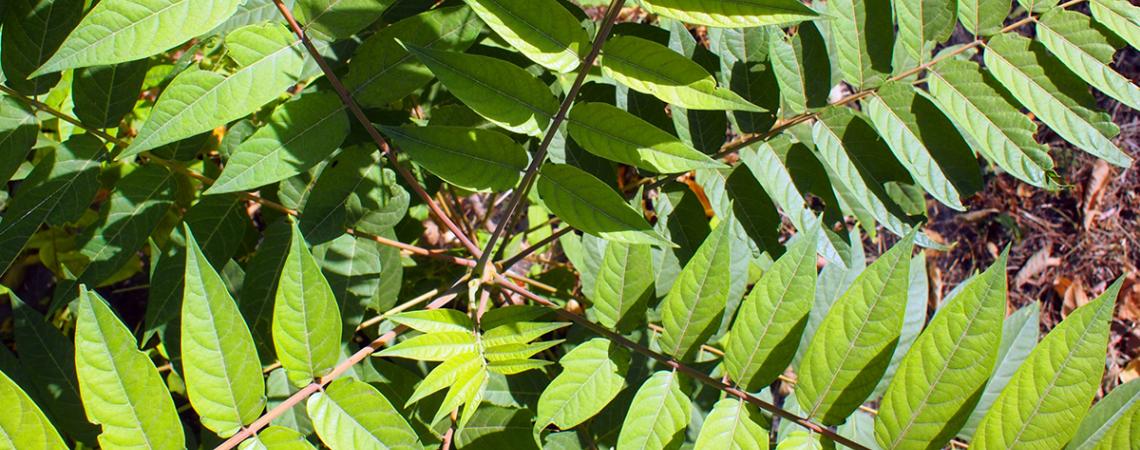Top view of a young sapling tree Ailanthus altissima
The invaders arrived deliberately or inadvertently. Either way, invasive plant species have wreaked havoc on our ecosystem. Just what is an invasive species? Essentially, an invasive species is one that is not native and whose introduction causes or is likely to cause economic, environmental, or physical harm to an ecosystem.
Lack of understanding and knowledge of invasive plant species is what brought them here. Regardless of the method of introduction, they all have done damage. Probably the most common problem is that invasive species crowd out native plants, damaging an ecosystem by altering the habitat of other plants and animals. They also can damage agriculture or forestry operations and even impact the recreational activities of humans. Invasive species may threaten biodiversity by causing diseases, introducing parasites, or by hybridizing with local species. They can eliminate food sources for native animals or alter soil chemistry and erosion rates. Additionally, they may change the frequency and intensity of wildfires and alter waterways and wetlands.
It’s estimated that at least 50,000 nonnative plant and animal species have been introduced into the United States. Of the 3,000 plant species found in Ohio, 75 percent are considered native, here before European colonization. Of the remainder, about 100 invasive plant species are considered problematic in Ohio, degrading our forests, wetlands, and prairies.
How did they become a problem? In some instances, the spread of invasive plant species occurred through the growth and movement of the population and the deliberate or inadvertent transport of seeds. Some species had medicinal uses. Other species were suitable, or so we thought, for forage, erosion control, or beauty or it was thought they had other desirable qualities.
The Top 10 list of invasive plants in Ohio includes the following:
1. Bush honeysuckle
2. Common buckthorn
3. Garlic mustard
4. Purple loosestrife
5. Common reed grasses
6. Autumn olive
7. Multi-flora rose
8. Japanese honeysuckle
9. Japanese knotweed
10. Narrow leaf cattail
I have my own “Top 5” list, which includes the following plants because of their widespread damage or potential for damage:
1. Kudzu vine: It was introduced to the United States in the late 1800s as an ornamental, for forage and erosion control. It crowds out native species by simply covering them up with its prolific and deep-rooted growth. Kudzu can be found in much of the South and in most of the central and eastern U.S., including Ohio, and a few western states. It is very difficult and expensive to eradicate.
2. Multi-flora rose: Planted since the late 1700s throughout most of the U.S. for erosion control, it creates dense, thorny, and impenetrable thickets that crowd out native plants and ruin pastures. Animals may spread the seeds.
3. Giant hogweed: This Asian native was introduced as an ornamental plant on the East Coast in 1917 and has spread across most of the northern United States. It is poisonous, and the sap can burn the skin or cause blindness. Eradication activities are hazardous. It can grow prolifically along waterways if unchecked. It is not yet known in Ohio but has been found in Michigan.
4. Eurasian watermilfoil: It was probably introduced into the United States by accident around 1950 but could have been here since the 1800s. It is an aquatic plant that forms thick dense mats of plant material in slow-moving waters. This causes it to crowd out native plants and interfere with recreational water activities, even reducing property values of nearby homes. If cut, the pieces will take root in another spot. It is widespread across the U.S. and almost impossible to eradicate.
5. Ailanthus: Sometimes referred to as Tree-of-Heaven, this tree looks tropical. It produces prolific numbers of seeds and will grow just about anywhere regardless of soil conditions. It competes for resources with native trees. The trees are often found growing on buildings, in alleys, or in other spots where their seeds drop. The sap can cause inflammation of the heart muscle. The pollen causes respiratory distress. The crushed leaves have a strong foul odor. The tree grows rapidly and can damage pavement or building foundations. It was introduced into the U.S. in the 1700s and planted as an ornamental. It quickly became unpopular due to its short lifespan, foul odor. and tendency to spread to unwanted areas.
Normally a combination of eradication methods can be successful in stopping the advance of invasive plant species. These methods include the use of herbicides, machines or human labor, and biological control, using a disease or parasite of the invasive species. Probably the most important and cost-effective method is prevention of further spread by keeping the invaders out. This is typically accomplished by quarantines, prohibitions against planting, public education, vigilance, and taxpayer dollars. Eradication of invasive species is often difficult because the exact qualities that make the plant successful are what makes it most difficult to combat.
Wayne Stephens of Wooster is a member of Holmes-Wayne Electric Cooperative. He is an Ohio Master Gardener Volunteer and a former member of the Tiffin Shade Tree Commission.









